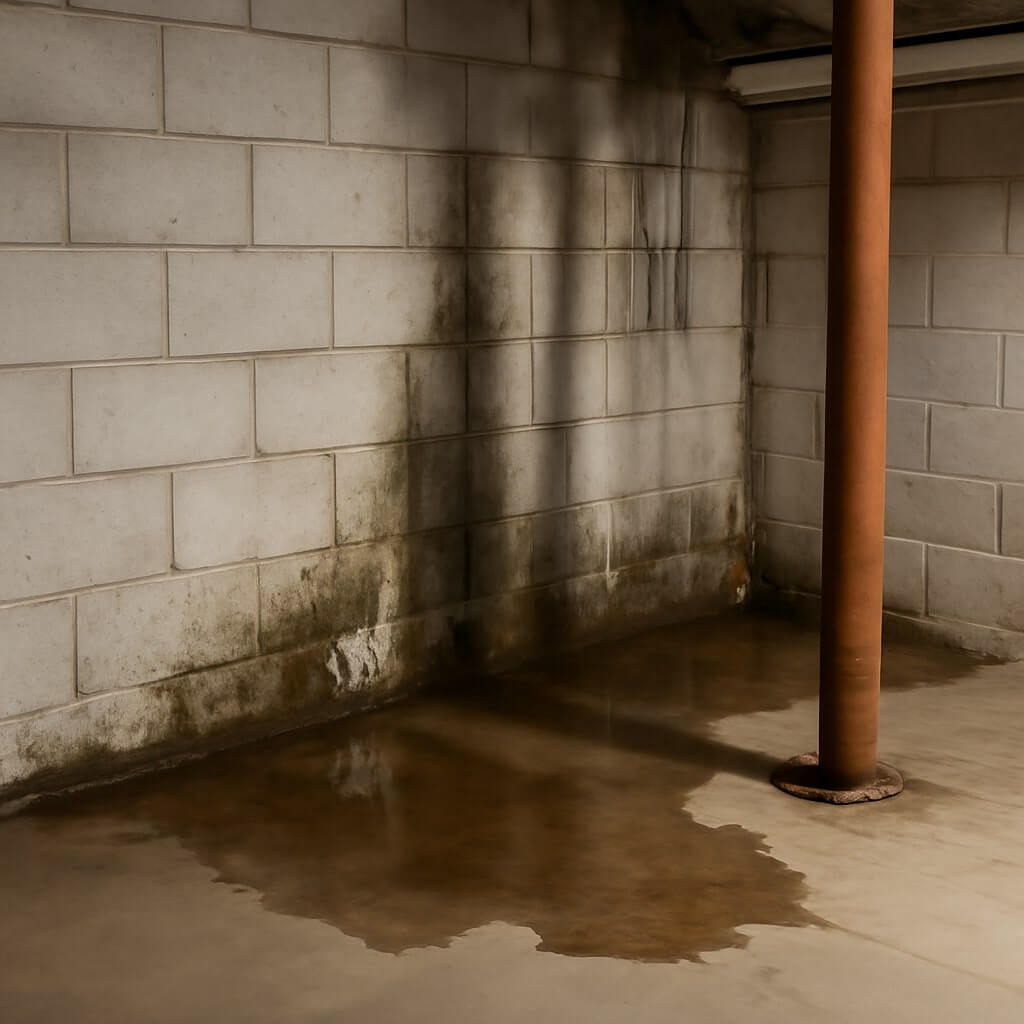If you notice visible water stains on your basement walls or floors, it could signal inadequate waterproofing methods. Mold and mildew growth often follows excessive moisture, while musty odors can indicate deeper issues. Peeling paint and cracks in the foundation further suggest water intrusion and compromised structural integrity. Understanding these signs is essential for maintaining a safe environment. However, what steps should you take to address these problems effectively?
Key Takeaways
- Visible water stains on walls and floors indicate potential waterproofing issues and may signal groundwater infiltration or improper drainage.
- Mold and mildew growth suggests excess moisture and inadequate waterproofing, requiring immediate attention to leaks and ventilation.
- Musty odors in the air often point to moisture problems linked to mold, stagnant water, or poor ventilation, affecting indoor air quality.
- Peeling or bubbling paint indicates moisture intrusion, disrupting paint adhesion and suggesting underlying waterproofing failures.
- Cracked or damaged foundations can compromise structural integrity and may signal inadequate waterproofing, necessitating regular inspections for safety.
Visible Water Stains on Walls and Floors
Visible water stains on walls and floors often signal a serious problem with your basement’s waterproofing. Identifying water stain patterns can help you pinpoint moisture sources.
Visible water stains indicate potential waterproofing issues in your basement; recognizing their patterns is crucial for identifying moisture sources.
For instance, horizontal lines might indicate groundwater infiltration, while dark patches near windows could suggest condensation issues. You should inspect areas where plumbing pipes run, as leaks often manifest as localized stains.
Additionally, check for stains following heavy rainfall, which could indicate improper drainage. By understanding these patterns, you can take proactive measures to address the underlying issues, improving your basement’s waterproofing and preventing further damage.
Don’t ignore these signs; they warrant immediate attention.
Mold and Mildew Growth
When you notice mold and mildew growth in your basement, it’s often a clear indication of inadequate waterproofing and excessive moisture levels.
To effectively implement mold prevention and mildew control, consider these steps:
- Identify and repair leaks: Check pipes, walls, and floors for any water intrusion.
- Improve ventilation: Use exhaust fans or dehumidifiers to reduce humidity.
- Seal cracks: Fill any gaps in walls or foundations to prevent moisture entry.
- Use mold-resistant materials: Opt for paints and finishes designed to inhibit mold growth.
Addressing these issues promptly will help maintain a dry, healthy basement environment.
Musty Odors in the Air
Musty odors in your basement often signal underlying moisture issues, typically stemming from mold or mildew growth.
Ignoring these odors can lead to health complications, including respiratory problems and allergic reactions.
To effectively address this issue, you’ll need to identify the source of the dampness and implement appropriate mitigation strategies.
Source of Odor
If you notice a persistent, unpleasant odor in your basement, it could signal underlying issues related to inadequate waterproofing.
Identifying the odor sources is essential for effective odor elimination. Here are common culprits:
- Mold and Mildew: Thriving in damp areas, they release musty smells.
- Stagnant Water: Accumulations can lead to decay and odors.
- Poor Ventilation: Lack of airflow worsens mustiness.
- Deteriorating Materials: Wet wood or insulation can emit foul scents.
Addressing these issues promptly helps maintain a healthy environment and prevents further complications.
Health Implications
Persistent musty odors in your basement can indicate more than just discomfort; they pose potential health risks. These odors often result from mold and mildew, which can lead to respiratory issues. Prolonged exposure can aggravate allergies and asthma, impacting your overall well-being. Understanding the specific health implications is essential for maintaining a safe living environment.
| Health Risk | Description | Symptoms |
|---|---|---|
| Mold Exposure | Allergens affecting respiratory function | Coughing, wheezing |
| Mildew Presence | Irritation and inflammation in airways | Sneezing, fatigue |
| Chemical Fumes | Volatile organic compounds from decay | Headaches, nausea |
| Poor Air Quality | Accumulated pollutants in the air | Dizziness, irritation |
Mitigation Strategies
To effectively combat musty odors in your basement, implementing a series of targeted mitigation strategies is crucial.
Consider the following steps:
- Improve Drainage Solutions: Confirm gutters and downspouts direct water away from your foundation.
- Install Sump Pumps: These devices help remove excess groundwater, reducing humidity levels.
- Seal Cracks: Use waterproof sealants on walls and floors to prevent moisture ingress.
- Ventilation: Increase airflow by installing vents or using dehumidifiers to keep humidity in check.
Peeling or Bubbling Paint
One of the most telling signs of inadequate waterproofing in your basement is the presence of peeling or bubbling paint on the walls. This issue often indicates poor paint adhesion due to moisture invasion, which can lead to further damage if not addressed. When water seeps into the walls, it disrupts the bond between the paint and the surface, causing unsightly imperfections.
| Cause | Effect |
|---|---|
| Moisture Invasion | Peeling Paint |
| Poor Paint Adhesion | Bubbling Paint |
| High Humidity | Compromised Walls |
Act quickly to prevent further issues!
Cracked or Damaged Foundation
The presence of peeling or bubbling paint can often signal deeper issues with your basement’s structure, particularly concerning the foundation.
Cracks or damage to your foundation can compromise its structural integrity. It’s important to conduct a thorough foundation inspection if you notice:
- Horizontal or vertical cracks wider than 1/8 inch.
- Crumbling or flaking concrete.
- Water pooling in your basement.
- Doors and windows that stick or won’t close properly.
Addressing these signs promptly can prevent significant damage.
Regular foundation inspections can help guarantee your home remains safe and structurally sound, protecting your investment in the long run.
Excessive Humidity Levels
When you notice excessive humidity levels in your basement, it often indicates inadequate waterproofing and can lead to a host of problems, including mold growth and structural damage.
Effective humidity control is essential; you should monitor moisture levels regularly. Installing ventilation systems can help circulate air and reduce humidity, promoting a healthier environment.
Additionally, make certain that any existing vents are unobstructed and functioning properly. If humidity remains high despite these measures, consider consulting a professional to assess your waterproofing methods.
Addressing these issues promptly can prevent costly repairs and maintain the integrity of your basement.
Water Accumulation in Corners
Water accumulation in corners can be a clear indicator of inadequate waterproofing in your basement. This issue often arises due to ineffective corner drainage or failing moisture barriers.
To address this problem, consider the following steps:
- Inspect the corner drainage system for blockages or damage.
- Check the integrity of moisture barriers; any tears could lead to leaks.
- Confirm proper grading around your home to direct water away from the foundation.
- Consider installing additional sump pumps to manage excess water effectively.
Taking these measures will help prevent further water accumulation and protect your basement from damage.
Insect and Pest Infestations
Inadequate waterproofing can lead to insect and pest infestations in your basement, as damp environments create ideal breeding grounds for unwanted critters.
You may notice an uptick in pests like termites, cockroaches, and rodents, all thriving in moisture-rich conditions.
Implementing effective pest control measures becomes essential to combat these infestations.
To guarantee insect prevention, regularly inspect your basement for cracks, leaks, or standing water.
Seal any entry points and maintain proper ventilation to reduce humidity.
Conclusion
Inadequate waterproofing can lead to serious issues in your basement, from visible water stains to mold growth and structural damage. If you notice any of these signs—like musty odors or peeling paint—it’s essential to address them promptly. Ignoring these problems can escalate into costly repairs and health risks. By taking action now, you can safeguard your basement environment and guarantee long-term stability. Regular inspections and maintenance are key to effective waterproofing and a healthy living space.

